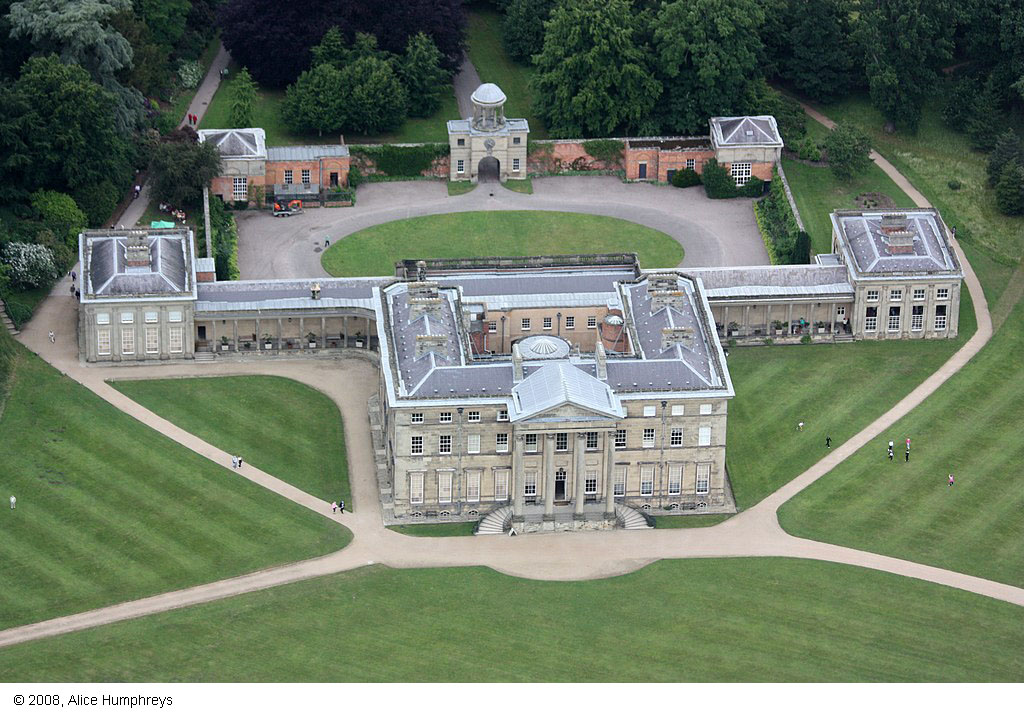Attingham Estate
Our first visit was to nearby Attingham Estate. Access was a tricky sharp turn off the main road through the impressive gateway entrance (a junction where the last Lady Berwick sadly died in a car crash 1972). A long drive, through cattle pasture and parklands with majestic oak and sycamore trees, led to the Hall. Having an hour to spare before the house opened, we set off on the Deer Park Woodland Walk. It was a grey, cold day; ten minutes in, the heavens opened! Sheltering under trees, we saw a group of fallow deer nearby doing the same. Not far away was the 600 year old Repton Oak, so-named for Humphry Repton who landscaped Attingham; perhaps it was a favourite spot of his, as it afforded a grand vista of the house and grounds.
After the rain we enjoyed the rest of the walk, with a pond, ducklings, moorhens, an old bridge over the River Tern (a Severn tributary), and returning over a newer suspension bridge. We dried off and warmed up with a coffee in the Carriage House Café, part of the attractively laid out old Courtyard, with a current display of some superb nature photographs.
Our visit to the Hall was self-guided. The house, built by the 1st Lord Berwick in 1785 who made his money in textiles, was certainly built to show off; the family motto being: “let wealth be his who knows its use”. Although still large, the Palladian style entrance hall is today only half its original size, as the 2nd Lord returned from his Grand Tour of Italy with many pictures, so the Hall had to make way for a Picture Gallery. Although most of the artworks were “in the style of …”, the gallery itself and what lay beyond were certainly Masterpieces. Designed by John Nash, the gallery had a glazed roof, allowing best light for picture viewing, and the double curved Nash staircase was stunning, topped by the beautiful glazed dome – all of these in vibrant shades of red.
I was a bit concerned I’d eaten the cherry before the cake, and that the rest of the house might be mere sponge, but there was much beauty and luxury to behold in other rooms too: the dining room in Pompeian red with fabulous white plaster work ceiling, where I learnt that wine glasses were not part of the table setting, but that wine was served, drunk, and glasses swiftly taken away(!); the Sultana room, richly red again, with its comfy Ottoman “settees”; the drawing room ceiling and an ultra-feminine boudoir in delicate gilded blue, based on Marie Antoinette’s, built for the 1st Lord’s wife. These were all highlights for me.
An ante-room was interesting; it served as Lady B’s dining room in 1939 when the mansion housed evacuee schoolgirls from Birmingham, and later was an Adult Education College. Also interesting were the hierarchical basement servant rooms, including a silver vault. The 1st lord left Attingham to his 18 year old son who – surprise! – swiftly squandered the family fortune. Although the Berwicks managed to hang on to the property for over 160 years, family fortunes rose and fell, and furniture and fripperies were often sold off, leaving the house empty for periods.
Luckily, the 8th Lord Berwick married a lady of refinement in 1919 whom he’d met in Venice. Together they did their best to revive and restore the place, and house parties were held again including guests such as Kipling, but they lived in genteel poverty and Lady B knew it could not survive without a considerable injection of cash. When Lord B died in 1947, Attingham was bequeathed with its 4000 acres to the NT, and Lady B continued to live in part of the house until her untimely death.
As part of this visit, Geoff had promised us “something special” …. This turned out to be a private visit to her ladyship’s two-story apartment within the Hall, not normally open to the public – thank you Geoff!
In 1986, Mr Edwin Cohen, a retired American stockbroker and collector, made it his home after an approach to the NT for a lease. Born into humble beginnings in Brooklyn in 1933, Mr Cohen did well for himself. An enigmatic character with artistic inclinations and passions, he crossed the Atlantic and fell in love with Windsor’s antique shops and Regency furniture in general. He became obsessed with obtaining prime pieces at auction and living the life of a Country Gentleman – which he did, quietly and alone, at Attingham until his death in 2020. It was a rare treat to see inside such a place, with its homely informal comfort, some modernisations such as his kitchen, but some regressions back to Regency style such as the Green Room, and Mr Cohen’s abundance of acquisitions. Regretfully the future of NT’s ability to show the apartment is under threat as a promised legacy from Mr Cohen’s estate has not been forthcoming.
All in all, Attingham was a first-rate first visit!
Jan Campbell
Harvington Hall (Historic Houses) 12th June 2024
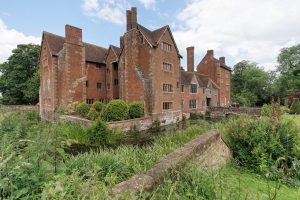 From Ironbridge, we travelled 30 miles to this rare example of an Elizabethan moated Manor house. The current Hall, built 1578 by Humphrey Pakington from soft red brick with many different roof lines, still looks stunning today. Even though two wings of the Manor house were demolished c.1700, there are still many interesting parts to visit. The wall paintings are the finest in the country, even though time has faded them and only outlines remain in some areas.
From Ironbridge, we travelled 30 miles to this rare example of an Elizabethan moated Manor house. The current Hall, built 1578 by Humphrey Pakington from soft red brick with many different roof lines, still looks stunning today. Even though two wings of the Manor house were demolished c.1700, there are still many interesting parts to visit. The wall paintings are the finest in the country, even though time has faded them and only outlines remain in some areas.
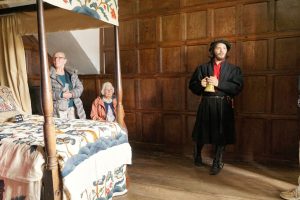 Rooms available to view included Lady Mary’s bedroom, with its beautiful tapestry hangings, and a closet which discharges into the moat; the Great Hall, repanelled in t he 1980’s; the nursery, where James our guide, regaled us with fearful examples of Elizabethan childcare; and an Elizabethan kitchen with two fireplaces and a bread oven – above which was a priest-hide! The Kitchen is still used for special occasions and has its own internal well taking water from the moat – which, filtered through sandstone, ran clear.
Rooms available to view included Lady Mary’s bedroom, with its beautiful tapestry hangings, and a closet which discharges into the moat; the Great Hall, repanelled in t he 1980’s; the nursery, where James our guide, regaled us with fearful examples of Elizabethan childcare; and an Elizabethan kitchen with two fireplaces and a bread oven – above which was a priest-hide! The Kitchen is still used for special occasions and has its own internal well taking water from the moat – which, filtered through sandstone, ran clear.
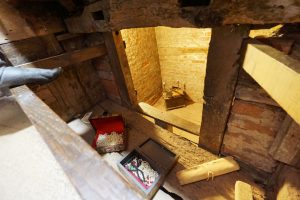 Elizabeth I had banned the Catholic Mass throughout the country with heavy fines of £20 per month (£4,000 today). for non-attendance at the new English Church service. Priests were thought to be spies for Catholic Spain, and could be tortured or killed once caught; raids were common. Harvington Hall was one of many properties owned by the Pakingtons and priests met there for mutual support – perhaps why so many priest hides were constructed there – more than in any other house in England. My favourite hide was under the stairs – cleverly constructed, as was the one which looked like a piece of wall in the Doctor’s Study.
Elizabeth I had banned the Catholic Mass throughout the country with heavy fines of £20 per month (£4,000 today). for non-attendance at the new English Church service. Priests were thought to be spies for Catholic Spain, and could be tortured or killed once caught; raids were common. Harvington Hall was one of many properties owned by the Pakingtons and priests met there for mutual support – perhaps why so many priest hides were constructed there – more than in any other house in England. My favourite hide was under the stairs – cleverly constructed, as was the one which looked like a piece of wall in the Doctor’s Study.
In a remarkable coincidence, we were joined in the tour by fellow members David and Vanessa Peckett, who were on their own holiday in the area and had decided to visit Harvington without knowing we would be there!
This was a most interesting place to see, and we ended our visit in the gardens, sampling an array of good home cooked food, in the sunshine.
Polli Appleyard.
Wightwick Manor (National Trust)
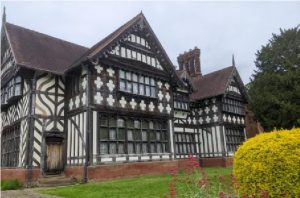 On the last full day of our visit to the West Midlands, we first went to Wightwick Manor, which the locals pronounce “Wittick”! The first view is of a black and white house making you think ‘Tudor’ or ‘Mock Tudor’, but it is actually a Pre–Raphaelite/Arts and Crafts house.
On the last full day of our visit to the West Midlands, we first went to Wightwick Manor, which the locals pronounce “Wittick”! The first view is of a black and white house making you think ‘Tudor’ or ‘Mock Tudor’, but it is actually a Pre–Raphaelite/Arts and Crafts house.
Like many NT properties, the house itself isn’t open until 11am, so we set off to explore the gardens first, passing a steep grassy bank with wild flowers. We walked through alleys flanked with clipped yew hedges and sweet-smelling roses. There was a theme of “Blossom Time” with arches of knitted pink and white blossoms and with poems, by the Poet Laureate, Simon Armitage. Glancing left were lovely vistas of parklands, lakes and woodlands below us. Further on, there were extensive orchards and a walled garden, which seemed to be a work in progress.
On reaching the entrance to the house there was something of a holdup as they were removing scaffolding from on-going renovations, and an American group “snook in” before us!
This late Victorian house, started in 1887 by Thomas Mander, is a temple to the Arts and Crafts movement, with wallpaper and carpets by William Morris, Ceramics by William de Morgan, paintings by his wife Evelyn and stained-glass windows by Charles Kempe.
I t was difficult to see some rooms properly, like the Great Hall, because of the on-going renovations. In the bedrooms, I was intrigued by an early hairdryer – a metal “squashed” cylinder with wooden handle and a line of spikes on top; it could be filled with hot water but looked to me like an instrument of torture!
We finished our tour back downstairs in the Drawing Room; a lovely airy room with its Morris carpets and wallpaper, and fascinating Kempe stained-glass windows illustrating the Four Seasons.
A very enjoyable visit, and the shop sold a number of items connected to the Arts and Crafts designs in the House.
Patti Tankard
Dudmaston Hall – (National Trust)
The present building dates from 17C and the same family have lived on site over 800 years. With beautiful grounds and interiors, it became home to Sir George and Lady Rachel Labouchere from 1966, when he retired as a career diplomat, until their deaths in late 1990’s .
Upon their return to UK, Lady Rachel, who had inherited Dudmaston, made its preservation, and eventual gift to The Trust, their joint project. The magic of their combined interests is an unexpected gem. Though classical in its building, grounds and setting, the insides of many rooms have been refitted, including a gallery to display a remarkable collection of modern and contemporary art.
Along with a collection of Chinese ceramics, paintings and sculptures, acquired by Sir George, were of particular interest including works by Ben Nicholson, Henry Moore and Barbara Hepworth. Some large items are placed in the gardens and grounds.
In contrast Lady Rachel, who was a talented botanical artist, chose to invest in a collection of botanical paintings and 18C Dutch flower pictures which added a breadth of interest. So enthralled were we that Dudmaston room guides had to remind us it was beyond closing time.
Susan Welch
Optional extra: Biddulph Grange Gardens (National Trust)
On the way home from Ironbridge, we made a cheeky visit here – a grade 1 listed Victorian garden bought by the National Trust in 1988. It is the largest restoration project in the Trust’s history.
Originally created 1842 -68 by James and Maria Bateman and artist Edward Cooke, it introduced themed rooms with individual microclimates, perfect for growing plants from around the world. The Grange itself is not open but the gardens were intended to provide a “playful paradise for people’s amazement”. The given map is an essential guide through “Egypt”, “Italy”, “Chin”, a “Himalayan glen”, and various other gardens, including the oldest stumpery in the country made from oak tree stumps, and the Wellington Avenue, which I found truly magnificent. With fish in the lake, a dahlia walk, quoit and tennis lawns, woodland walks on various levels, and tunnels, there was much to see. Had the weather been kinder, we would have stayed longer and enjoyed refreshments in the small but beautiful café.
Polli Appleyard.
I should like to thank everyone who took part in our holiday to Ironbridge. All went well and we were lucky with the weather – cool but not too wet during visits. The hotel and staff did a wonderful job looking after us all. Attingham was a good start, with the contrast of downstairs and the upstairs which had been rented out to a rich American who’d spent his life visiting salerooms and buying furniture.
Harvington Hall was a complex old property owned by a Catholic family. We had two excellent guides who gave much history of the house.
Then the final day at Wightwick Manor, where renovation was being carried out on the woodwork and old glass windows, and finally, Dudmaston, an old farmhouse giving us the feeling of a home.
Thank you to those who wrote reports of our visits.
Geoff

